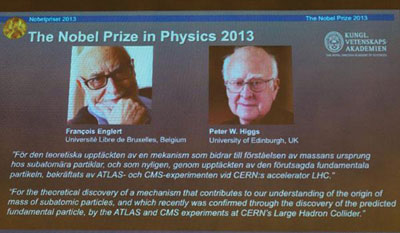Archives
The God Particle
delivered lectures both at the national and international levels, and was even sure (theoretically) of the existence of the ‘God particle’ much before CERN Director General- Rolf Heuer made the declaration on July 2012. More than 50 years ago, Peter Higgs and five other theoretical physicists proposed that an invisible field lying across the universe gives particles their mass, allowing them to clump together to form stars and planets. Since the 1960s, scientists have been searching for the Higgs, but the search began in earnest more than 20 years ago through an early experiment at CERN in Europe and Fermilab in the US.
 Having understood a little about the significance of the work and the contributions by Parida, we were not surprised to read in the news: ‘The Columbia University physicist had organized a wee-hour gathering of physicists and students in the U.S. to watch the announcement, which took place at 9 A.M., Geneva time. Heuer, while speaking to a packed audience in Geneva, confirmed that, two separate teams: 1. ATLAS (A Toroidal LHC Apparatus) and 2. CMS (Compact Muon Solenoid), working at a Large Hadron Collider (LHC) are more than 99 percent certain that they have discovered the Higgs boson which is also known as the God particle - or at the least a brand-new particle exactly where they expected the Higgs to be. We have a discovery. We have observed a new particle consistent with a Higgs boson. “I think we can all be proud…. but it’s a beginning,” Heuer said. The long - sought after particle may complete the standard model of physics by explaining why objects in our universe have mass and in so doing, why galaxies, planets and even humans have any right to exist.
Having understood a little about the significance of the work and the contributions by Parida, we were not surprised to read in the news: ‘The Columbia University physicist had organized a wee-hour gathering of physicists and students in the U.S. to watch the announcement, which took place at 9 A.M., Geneva time. Heuer, while speaking to a packed audience in Geneva, confirmed that, two separate teams: 1. ATLAS (A Toroidal LHC Apparatus) and 2. CMS (Compact Muon Solenoid), working at a Large Hadron Collider (LHC) are more than 99 percent certain that they have discovered the Higgs boson which is also known as the God particle - or at the least a brand-new particle exactly where they expected the Higgs to be. We have a discovery. We have observed a new particle consistent with a Higgs boson. “I think we can all be proud…. but it’s a beginning,” Heuer said. The long - sought after particle may complete the standard model of physics by explaining why objects in our universe have mass and in so doing, why galaxies, planets and even humans have any right to exist.
What are Higgs boson and the Higgs field? The Higgs field has been described as a kind of cosmic ‘treacle’ spread through the universe. According to professor Higgs’ 1964 theory, the field interacts with the tiny particles that make up atoms and weight them down so that they do not simply whizz around space at the speed of light. But in the half - century following the theory produced independently by the six scientists namely Belgian physicist Francois Englert (80) and Robert Brout who died in 2011, Britain’s Peter Higgs (84), American Carl Hagen, Gerald Guralnik and Britain’s Tom Kibble, within a few month of each other nobody has been able to prove that the Higgs field really exists. The particle associated with the field is the Higgs boson. Without it, all elementary particles would be without mass and would zip around at a speed of light. There would be no atoms and as such, no humans.
Even though, the ‘God particle’ has been found, which is a historic milestone for Higgs boson hunters, Jonathan Brown sets out the really big question for the brightest minds to answer. The God particle may have been found ‘but so much of the universe remains unknown’. The idea behind this article is to enlighten the readers as to why the Higgs field or Higgs boson is called the ‘God particle’.

First of all, let us begin with the question - What is the God Particle? The ‘God Particle’ is the nickname of a subatomic particle called the Higgs boson. In layman’s terms, different subatomic particles are responsible for giving matter different properties. One of the most mysterious and important properties is mass. Some particles like photons do not have mass. The Higgs boson or ‘God particle’ is believed to be the particle which gives mass to matter.
The standard model of particle physics is a system that attempts to describe the forces, components, and reactions of the basic particles that make up matter. It not only deals with atoms and their components, but the pieces that compose some subatomic particles. This model does have some major gaps, including gravity. Each of the subatomic particles contributes to the forces that cause all matter interactions. One of the most important but least understood aspects of matter is mass. According to the standard model theory, it would not be recognizable, without something to give the basics building blocks of matter. Nature around us would behave as light does, floating freely and not combining with other particles. Ordinary matter, as we know it, would not exist. Everything from plants, animals, people to stars and planet consist of just a few building blocks of matter particles. Modern science suggests that ‘normal’ matter constitutes just 5 percent of that space, with the rest made up of dark energy.

In layman’s terms the Higgs field was famously imagined by physicist David Miller as akin to a room full of political party workers spread evenly throughout a room. There will be some people (in Miller’s example an anonymous person) who passed through the crowd with ease, paralleling the inter action between the fields and mass-less photons. There will be other people (in Miller’s example the British Prime Minister) who would find their progress being continually slowed by the swarm of admirers crowding around him/her, paralleling the interaction of particles that acquires a finite mass.
| The ‘God Particle’ is the nickname of a subatomic particle called the Higgs boson. In layman’s terms, different subatomic particles are responsible for giving matter different properties. One of the most mysterious and important properties is mass. Some particles like photons do not have mass. The Higgs boson or ‘God particle’ is believed to be the particle which gives mass to matter. |
Physicists believe the universe brims with energy that acts like a cosmic molasses, imbuing the particles that move through it with mass, the way a bill moving through parliaments attracts riders and amendments becoming more and more ponderous.
The ‘God particle’ is reportedly a term physicists avoid using, as it appears contradictory to their work. Peter Higgs, an atheist after whom the particle is named, said in 2008 that he felt the term might be offensive to some. “I find it embarrassing because, though I’m not a believer myself, I think it is the kind of misuse of terminology which I think might offend some people,” he said at the time. One explanation is that the term ‘God particle’ arose as the media began reporting on the work of scientists looking for the elusive Higgs boson, making it a pop culture reference. Some claim the name fits, as this particle is believed to be the building block of all life, as Peter Higgs once said “…if it wasn’t there, we wouldn’t be here”.
 Noble Laureate Leon Lederman, an Illinois physicist, is credited with introducing the term ‘God particle’. Although he admitted that he originally referred to the Higgs Boson particle as the ‘goddam particle’ due to the expense and challenges involved in looking for it. Writing in his 1993 book, The God Particle: If the Universe is the Answer .What is the Question? Lederman reveals: “This boson is so central to the state of physics today, so crucial to our final understanding of the structure of matter, yet so elusive that I have given it a nickname - the ‘God Particle’. Why God Particle? Two reasons: 1. The publisher would not let us call it the Goddam Particle, though that might be a more appropriate title given its villainous nature and the expense it is causing and 2. There is a connection, of sorts, to another book, a much older one…”
Noble Laureate Leon Lederman, an Illinois physicist, is credited with introducing the term ‘God particle’. Although he admitted that he originally referred to the Higgs Boson particle as the ‘goddam particle’ due to the expense and challenges involved in looking for it. Writing in his 1993 book, The God Particle: If the Universe is the Answer .What is the Question? Lederman reveals: “This boson is so central to the state of physics today, so crucial to our final understanding of the structure of matter, yet so elusive that I have given it a nickname - the ‘God Particle’. Why God Particle? Two reasons: 1. The publisher would not let us call it the Goddam Particle, though that might be a more appropriate title given its villainous nature and the expense it is causing and 2. There is a connection, of sorts, to another book, a much older one…”
The much older book Lederman notes is the Bible and its account in Genesis 11:1-9 of Tower of Babel, which he re-interprets as “And the whole universe was of many languages, and of many speeches. And it came to pass, as they journeyed from the east that they found a plain in the land of Waxahachie and they dwelt there. And they said to one another. Go to, let us built a Giant Collider whose collisions may reach back to the beginning of time. And they had super conducting magnets for bending and protons had they for smashing.”
And the Lord came down to see the accelerator which the children of men built. And the Lord said, “Behold the people are un-confounding my confounding. And the Lord sighed and said, Go to, let us go down, and there give them the God Particle so that they may see how beautiful is the Universe I have made”- The Very New Testament 11:1.
In conclusion, we hope that this write-up of ours, will enlightened the readers, and we sincerely appeal to all the greatest minds and researchers of the region to throw light on this very interesting find - dark matter or are we closed to the theory of everything.

